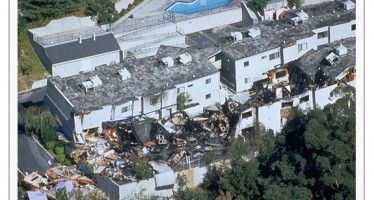Green Power Project Jolts Citizens
By KATY GRIMES
In the Southern California city of Chino Hills, there is a palpable anger spreading as the landscape is changing from bedroom community to industrial park. The bedroom community landscape now includes 200-foot electrical towers near homes, churches and parks.
The Tehachapi Renewable Transmission Project has had many of the 76,000 Chino Hills residents up in arms, but they are now left feeling impotent against one of the largest power providers in the state. Residents are watching helplessly as the installation of new massive electricity towers — 200 feet tall and 60 feet wide — are erected quickly, as close as 40 feet from some residents’ backyards.
Southern California Edison’s Tehachapi Renewable Transmission Project will cost a total of $1.8 billion in order to access and construct renewable energy generators from Kern County to western San Bernardino County. The City of Chino Hills has proposed various alternate routes that would move the transmission lines away from residential communities and schools into a local state park area, but were rebuffed by the California Public Utility Commission.
The state’s “green” agenda is behind the push for the 173 miles of new, high-voltage transmission lines and other “renewable” energy power projects. And apparently, some energy projects have been accelerated because of American Recovery and Reinvestment Act money — federal stimulus money for “shovel-ready” projects.
Proponents have argued that California’s grid must be updated to be able to carry renewable energy throughout the state as mandated by the Legislature. But, as energy experts have testified around the country, there is no reason why new transmission lines would necessarily carry more or cleaner power as solar and wind power have proven to be unreliable. The cheapest, most abundant power remains coal, which is likely to continue powering the bulk of California’s electricity.
Renewable Energy Mandate
The Tehachapi project is under construction in response to the California Renewable Portfolio Standard, which was mandated by the Legislature and signed into law on April 12, 2011 by Gov. Jerry Brown. Sen. Joe Simitian, D-Palo Alto, authored SB 2, which mandates the increase of California’s Renewables Portfolio Standard (RPS) to 33 percent by 2020. The mandate requires regulated sellers of electricity to procure 33 percent of their total energy supplies from certified renewable resources.
Opponents of the renewable mandate say that this will increase California’s energy costs by $7 billion, sparking a dramatic increase in the cost to the state’s utility rate payers.
In 2009, the California Public Utilities Commission warned the Legislature that increasing the renewables standard would cost utility companies in the state “tens of billions of dollars” and boost electricity costs to ratepayers. In its 2009 Legislative Summary, the CPUC wrote about Democratic Sen. Joe Simitian’s previous bill, SB 14, “[A]s drafted this measure would make it more difficult and costly to achieve this very important goal,” and it “adds new regulatory hurdles to permitting renewable resources in the state, at the same time limiting the importation of cost-effective renewable energy from other states in the West.”
Unfortunately, once the RPS bill was signed into law, all bets were off and energy producers have no choice but to comply — and ratepayers no choice but to pay.
Singing a contrasting tune to the 2009 report to the Legislature, on March 14 2011 CPUC President Michael Peevey told a legislative committee that the CPUC is continuing to push on the renewable standard. He added, “I think the state can go to 40 percent renewables by 2020.”
And now Chino Hills appears to be the sacrificial energy lamb.
In October 2010, Southern California Edison (SCE) contractors began removing the old, mostly idle, 200 kilovolt (kV) transmission lines and installing new, beefier, 500 kV transmission lines. But many residents have been complaining that the power towers are too close to homes and worry about living so closely to electro-magnetic frequencies and radiation.
 Southern California Edison Project
Southern California Edison Project
The application for the Tehachapi project was filed in 2007 and approved in 2009. During the ensuing years, the PUC held public hearings.
Residents who attended the public hearings explained that at the heart of the issue is the easement route now being accessed by SCE. The easements and existing towers had been inactive for 40 years.
SCE is now building on the easement route that has legally been their right-of-way for many decades, even before any homes were built. However, the old lines and towers on the Chino Hills easement were standard in size and voltage, but have been inactive for the past 40 years.
Most residents with historical knowledge of the area said there was a common belief that SCE did not have plans ever to use the easement or old power lines — until the Tehachapi project.
Where this belief becomes reality is that in the ensuing 40 years, communities and homes were built around the inactive easement, all with the appropriate approval and permits issued by the County of San Bernardino.
Several residents indicated it was widely assumed that any future energy upgrades would include standard sized towers previously used, along with “standard” voltage. Residents said that they never imagined the 200-foot tall, 500 kV towers now part of the 150-foot easement.
The residents of Chino Hills said they have only been asking for an alternative route and more time to develop a better and safer plan. Given that Chino hills spent $2.4 million on experts, lawyers and specialty engineers to fight SCE to develop an alternate route through the Chino Hills State Park — approved by environmentalists and other agencies — they felt would get attention from the CPUC.
However, the CPUC has summarily dismissed the concerns of the residents over the interest of visitors to the local state park. This excerpt from CPUC’s Final Decision for the project is one of the stated reasons why they dismissed Chino Hills’ alternate routes through the Chino Hills State Park:
“The Chino Hills State Park is an important regional resource serving at least 97,000 visitors each year. One key purpose of parklands is to serve ‘as a natural respite for the area’s human inhabitants,’ which clearly heightens the importance of visual impacts. Hence, visitors to parks would be more greatly impacted by visual impacts than similarly situated residents, and there are more visitors to the CHSP than there are residents of Chino Hills.”
The CPUC showed blatant disregard for the permanent residents of Chino Hills in favor of occasional visitors to the state park. Denise Cattern, Public Information Officer for the City of Chino Hills, said it was the residents who lobbied for the state park. and use it extensively.
Tehachapi Renewable Transmission Project
Upon completion, SCE says the Tehachapi Renewable Transmission Project will provide renewable wind-generated electricity and help meet California’s renewable energy goals.
However, even while SCE was shepherding the project through the tedious environmental-impact process, residents protested and appealed the PUC’S decisions to allow SCE to install the 500kV High Voltage Power Lines so close to homes and parks.
 “They are 200 feet tall — higher than the Statue of Liberty — and are placed next to people’s homes,” Chino Hills resident Irene Udo said in a recent interview. “We are the only city in the USA to have this type of power line running through residential homes.” And Udo expressed the concern held by many in the city about electromagnetic fields. “The EMF research is quite powerful,” she said.
“They are 200 feet tall — higher than the Statue of Liberty — and are placed next to people’s homes,” Chino Hills resident Irene Udo said in a recent interview. “We are the only city in the USA to have this type of power line running through residential homes.” And Udo expressed the concern held by many in the city about electromagnetic fields. “The EMF research is quite powerful,” she said.
Despite public hearings, residents said the “Tehachapi Clean Energy Project” was jammed down their throats by the PUC and SCE, with blanket approval of each phase of the project. Residents as well as city officials I spoke with said the CPUC and SCE were in lockstep about the scope and direction of the project from the inception, leaving residents to feel that even the public hearing process was just a formality.
SCE Public Information Officer Paul Klein said, “SCE has been a leader in renewable energy” and already generates 19 percent of the energy it produces from renewable sources. “We are already ahead in the renewable area.” Klein explained that the Tehachapi project includes 173 miles of new transmission lines with the goal of providing 4,500 megawatts of renewable electricity generation. “Renewable energy has to be addressed,” he said.
The city of Chino Hills has fought SCE over the increase in size of the towers as well as the 150-foot easement grandfathered into their city. “Outside of Chino Hills, throughout the rest of the project the easement is 250 feet,” said Cattern. “And 500 kV is not typical. It’s a crazy amount of high voltage for a residential area.” Cattern emphasized, “This isn’t just ‘I don’t want power lines in my backyard.’”
Cattern said that the city has spent $2.4 million trying to get the PUC to require SCE to honor a 250-foot easement or re-routing the line, as well as questioning the high voltage. And the city has made numerous alternative proposals for the project.
For clarification, Wikipedia states, “Electric power transmission or ‘high voltage electric transmission’ is the bulk transfer of electrical energy, from generating power plants to substations located near population centers. This is distinct from the local wiring between high voltage substations and customers, which is typically referred to as electric power distribution. Transmission lines, when interconnected with each other, become high voltage transmission networks.”
Energy Experts
Chino Hills hired energy and electricity experts to testify on behalf of the residents of the city at the CPUC hearings. During testimony, experts said SCE “significantly understated the potential maximum levels of the electric and magnetic fields along Segment 8A.”
California State University Sacramento Transmission Engineering Professor Turan Gonen told the CPUC, “To arrive at its calculation of magnetic fields at the edge of the right of way, SCE estimated the magnetic fields from the proposed line based only upon the initial amount of electricity the lines are expected to carry in the near future. But the capacity of the lines is actually four times higher than the value SCE assumed in calculating the magnetic field.”
Gonen warned that, as demand grows for electricity in Southern California, the transmission lines will likely carry electricity at their capacity. “The result is that the people living next to the lines in Chino Hills, as well as those in Chino and Ontario, could be exposed to magnetic fields as high as 110 mG […] on a temporary or sustained basis rather than the 27 mG estimated by SCE.”
The other issue is the 150-foot easement. “Throughout the 173-mile TRTP project, the only segment with such a narrow 150-foot ROW (right of way) is the segment through Chino Hills, Chino and Ontario that includes the 3.5 miles of densely populated neighborhoods in Chino Hills, Gonen said and wrote in testimony to the PUC. And SCE admits that there is only one example in the United States where homes abut double-circuit 500 kV lines in a 150-foot right of way. In that case, the property owners had a choice about living next to the lines because the lines were there first — this is not the case in Chino Hills.”
SCE’s Klein said they went through “a very long and thorough review process by the PUC,” and “there was extensive public access.” According to SCE, “Thousands of residents were contacted by SCE and the CPUC about the five to seven miles of line going through Chino Hills.”
It appears that there was a long review process. However, nothing changed for Chino Hills. They are still left with the installation of the 200-foot electrical towers and high capacity power lines next to homes.
According to Chino Hills residents, conflicting information has not been resolved. “Why are they not allowed to build these power poles within 300 yards of a school (250 kV lines), but yet they can put 500 kV lines directly over our homes?” one resident sent in an email. “You can’t even have a pacemaker and be near one of these things, and it’s been proven that florescent bulbs will light up” if held near a tower. “People are writing us from Europe saying the only places these 500 kV lines are being allowed is in the countryside.”
SCE and the PUC
The Tehachapi project is part of the Renewable Energy Transmission Initiative (RETI) process, a statewide initiative created to “identify the transmission projects needed to accommodate the renewable energy goals and mandates, support future energy policy, and facilitate transmission corridor designation and transmission and generation siting and permitting.”
It appears to be a process to identify how to acquire federal money for renewable energy projects in the state.
According to one energy expert who asked to remain anonymous, some of the projects for consideration are necessary and some are not. There are many energy experts who agree that the Tehachepi project is important for wind development. However, experts question how the projects are doing financially because of financing issues and environmentalist challenges.
Wind projects always have a” raptor component”; the turbines kill hundreds of golden eagles and other protected raptors every year, resulting in lawsuits and shutting down the wind farms.
On October 12, 2009, Federal Energy Secretary Ken Salazar and California Gov. Arnold Schwarzenegger signed what they called “a model of federal-state initiative and cooperation” which created “expedited review” and processing and Recovery Act funding to spur the development of “environmentally appropriate” renewable energy on U.S. lands in California.
Then through the American Recovery and Reinvestment Act of 2009, the federal stimulus program, President Obama and Congress made $41 million available “to facilitate a rapid and responsible move to large-scale production of renewables on public lands.” The Act directs economic stimulus funding to qualified renewable energy projects that begin construction by December 1, 2010.
The Tehachapi project was started in October 2010.
With so much federal money in the mix, there is much more at stake than SCE or the CPUC appear to be admitting to. The outcome appears to have been decided at the outset of the project, as happens with so many large-scale projects.
But the residents of Chino Hills have valid concerns and appear to have been railroaded by another big octopus. There is still time to halt the project and look at the viable alternatives proposed by the city, which it does not appear has been done with any sincerity by the CPUC.
In a thoughtful letter published in the Orange County Register after the CPUC approved SCE’s Tehachapi project, Mayor Ed Graham spelled out what the citizens of Chino Hills have been going through: “Southern California Edison, hiding under the cloak of delivering politically correct ‘green energy,’ can get the CPUC’s approval to build anything on their existing rights-of-way with complete disregard for people impacted along the way and even disregard for their own standards. Our entire community is permanently disfigured by the CPUC’s decision.”
Graham warned that any California city or town could be next, and asks how the CPUC could possibly be fulfilling its mission of providing “reliable utility service and infrastructure at reasonable rates, with a commitment to environmental enhancement and a healthy California economy.”
Related Articles
Sacto's Ongoing Redevelopment Disaster
APRIL 19, 2011 By RICHARD TRAINOR Since its inception in 1953, the Sacramento Housing and Redevelopment Agency has been driven
Tax break could help quake-proof buildings
Governments use tax breaks to encourage activity. In California, that includes driving electric vehicles and making movies. Now a 30
'Emergency' Relieves Bureaucracy
OCT. 26, 2010 By KATY GRIMES Last Thursday a mentally ill young man walked into a mall in Placer County,




